Get Tech Tips
Subscribe to free tech tips.
Coil Cleaners: A Guide to Which Cleaners to Use in Various Applications
Spring and fall are the seasons where all service technicians get turned into janitors. Some techs see this as a chore and don’t particularly enjoy the routines of checklist maintenance. However, it is important to remember that the “shoulder seasons” provide an opportunity for us to perform vital maintenance on systems in order to keep them operational during the more extreme weather months.
One of the biggest parts of any maintenance is cleaning the evaporator and condenser coils. Extremely dirty coils will negatively affect the performance and capacity of a system; they can even lead to reduced airflow and serious component failure due to high or low pressure in the coils. Many times, technicians chase what they think is a refrigerant charge problem, when really they have a cleanliness issue in the coils.
Coil cleaners can be found in a wide spectrum of acidity, alkalinity, colors, and strengths. It’s important to select the right one for your application and even more important to use safe practices when handling any cleaner. In this article, I want to highlight the main types of cleaners technicians use. I will also break down when and where each should be used and the safety practices to implement when using them.
Before I go any further….
We are MASSIVE fans of Refrigeration Technologies. It is the brand we use at Kalos and did well before they became a sponsor. I understand as techs you don't always get to choose your cleaners so we are going to do a more general look at cleaners.
Blue Cleaner
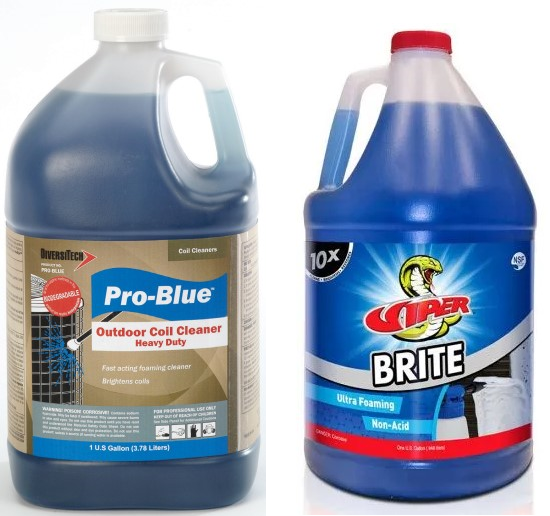
I’m not going to use brand names in this section of the article (I’ll discuss those later on), but we all know the blue cleaner. It’s a high-alkaline cleaner that is extremely slippery in your hands if you ever get it on you. The blue stuff is primarily used as a degreaser and coil brightener for the outdoor coil. I’ve been in many circumstances where the coil was outside a restaurant and caked with grease where the only cleaners that could remove the muck were high-alkaline cleaners.
When handling any cleaners, be sure to wear gloves and protective eyewear. I’ve been splashed in the eye with blue cleaner before, and it does not feel good at all!
Brown Cleaner

Often labeled as “Extra Heavy Duty,” this brown cleaner is typically a more concentrated alkaline coil cleaner than the blue cleaner. This brown cleaner is another great solution for ultra-greasy applications and really impacted coils. In my personal experience, I’ve had only one occasion to use this cleaner, and it was for a coil I knew would not last too much longer anyway. These high-alkaline cleaners are very corrosive if not rinsed off properly. Some labels may even tell you if the cleaner is non-corrosive. However, that is in relation to the proper mixing ratio. The liquid in the bottle is still highly corrosive and dangerous if not handled properly. Even if these cleaners are rinsed off the coil, sometimes the brief contact these cleaners have on the coil is enough to still do some damage to older coil fins. So, be careful!
No matter which coil cleaner you are using, ALWAYS read the label and select the appropriate mixing ratio for your application. A high concentration ratio can strip coil coating away and damage paint and wire insulation. In fact, if you have a coated coil, NEVER use high alkaline or acidic cleaners, as these will strip the coating away.
Green Cleaner
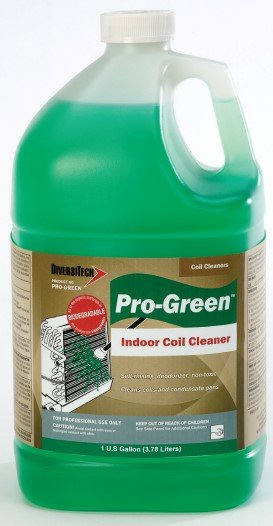
The green cleaner is typically the color code for the evaporator/indoor coil. Many times, when used in the right dilution ratio, this cleaner is self-rinsing (which means the condensation off the evaporator coil will be enough to rinse the cleaner away, and the cleaner is safe for the drain pan/line).
While this cleaner is definitely milder than the blue or brown, it’s still an alkaline cleaner and can do damage to your skin if it makes contact. I had a friend/coworker who accidentally spilled concentrated green cleaner on his tennis shoes at work (I know, he shouldn’t have been wearing tennis shoes in the first place), and he just left it there. It wasn’t until hours later that he had to remove his shoes because of the pain. When he took his socks off, his toenails had dissolved to a greenish-yellow goo! So please, be careful with this cleaner as well and pay attention to what it comes in contact with.
Pink Cleaner

The pink cleaner is always fascinating to me. It can be either reddish-pink or neon pink, but both are acidic cleaners, not alkaline. There are some acid cleaners that are dark purple as well, and they are generally used in descaling solutions for cooling towers. The purple ones can sometimes contain a dye that changes color when it reacts to scale. These cleaners are typically some mixture of hydrochloric, citrus, glycolic, and phosphorous acids.
The one acidic cleaner type I would NEVER use on coils is hydrofluoric cleaner. These are usually also pink in color and are labeled as (HF) on the datasheet. Be careful not to pick any of these types of acidic cleaners up for use on condenser/evaporator coils, as they can dissolve the fins (and your skin) rather quickly.
I’ve used pink cleaner once, and while it did a decent job, I didn’t think it performed as well as the high-alkaline cleaners. The foaming action on the acid cleaners I used was less impressive as well.
Foaming Cleaners
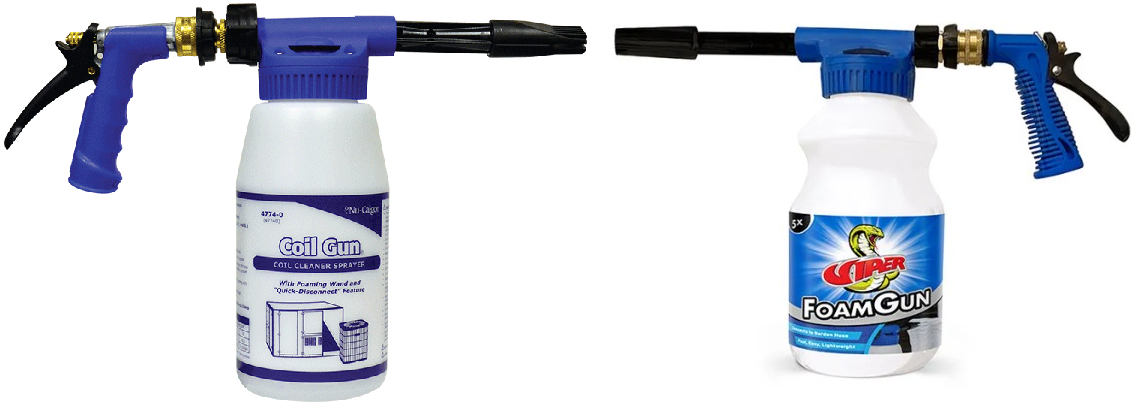
All the cleaners mentioned so far have a foaming agent involved in their chemistry. Foaming is important because most cleaners do their best “work” in the foam. The foam aids in pushing out the dirt and dislodging the grease from the surface of the coil fins. Most cleaners need 7-10 minutes of contact time with the coil before being rinsed off. That dwell time ensures that the cleaner can remove the dirt and grime, and it’s typically short enough that the cleaner doesn’t damage the coil itself.
To achieve good foam, most cleaners require the use of a coil gun. A lot of techs use a pump sprayer on every coil for every application. I love good pump sprayers, but they limit the power of the cleaners you use because they really don’t allow the cleaner to foam well at all. I highly recommend the purchase of the appropriate coil gun with the use of coil cleaners. It is important to use the right coil gun because the two different brands pictured above have wildly different mixing ratio settings. Nu-Calgon ranges from 10:1-3:1, while Refrigeration Technologies ranges from 80:1-5:1.
You may not always have access to a hose, but when you do, the results between a pump sprayer and a foam gun are night and day.
Detergent Cleaners
Detergent cleaners are typically some of the mildest cleaners you can get for your coils. Many green cleaners classify as detergent cleaners as well. Their primary job is to clean, degrease, and deodorize. They are best for lightly soiled coils. Some coil coatings require using only the mildest detergent cleaner to protect the coating from being scrubbed away.
Aerosolized Cleaners

Aerosol spray cleaners are very common, and they have the advantage of having very high foaming action. These cleaners are usually aerosolized versions of green cleaners. However, there are stronger formulations as well. I find that spray cleaners are best used in applications where the coils are difficult to reach. If the coil is accessible but still highly compacted with dirt and grime, I will often first use a spray-can cleaner; it can penetrate the coil and break up the dirt more quickly than a spray gun or pump sprayer.
Refrigeration Technologies
I’ve stuck to generalizing my vocabulary when it comes to discussing the main types of cleaners technicians use. However, I’d like to segue into a couple of cleaners that Refrigeration Technologies makes. These cleaners are a little different than the typical cleaners you may be used to, and they are worth talking about.
Viper HD
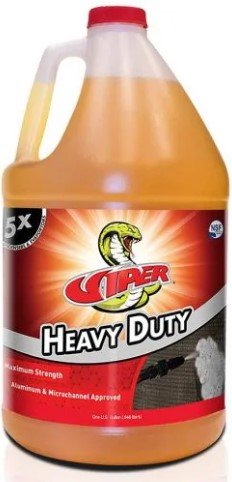
While Viper HD is not a truly pH-neutral coil cleaner, it’s the closest you’re gonna find on the market, at least that I’ve found. It tips slightly alkaline, but this stuff, even in its concentrated state right out of the bottle, is safe to handle in your bare hands. Its pH is around 8.5-9, which is the alkaline level of an egg or baking soda. Most alternative alkaline cleaners have a pH of 12-14. I’m not advocating for everyone to go out and bathe in Viper HD, but the pH is a key feature of this product.
Viper HD is high-foaming, and I’ve personally found the cleaning results to be as good as most blue and brown cleaners. Because it’s milder, it does need a few more minutes to sit on the coil before you rinse it, but I’ve never worried about it tipping over, spilling in the truck, and damaging tools. Also, at a 20:1 dilution ratio or higher, this cleaner can be used without rinsing.
Viper Evap+

Evap+ is Refrigeration Technologies’ version of a green cleaner. However, this cleaner can be used undiluted and uses enzymes to help break down the biofilm left behind from the dirt and grime that accumulates on the surface of coils. The enzymes stay active for up to 5-6 days after application. That basically deprives any new bacteria of the food it needs to survive and grow. Also, the pH level for this cleaner is the same as the Viper HD (8.5-9 pH) as opposed to most green cleaner alternatives, which are normally between 11-13. So once again, this cleaner is safe to use, and you can handle these chemicals with more ease than other more corrosive cleaners.
None of what I just said is to say that you should not use the proper PPE or safety best practices when handling Viper cleaners. Please be safe and smart with any and all chemicals at all times.
Viper Venom Concentrated Cleaners
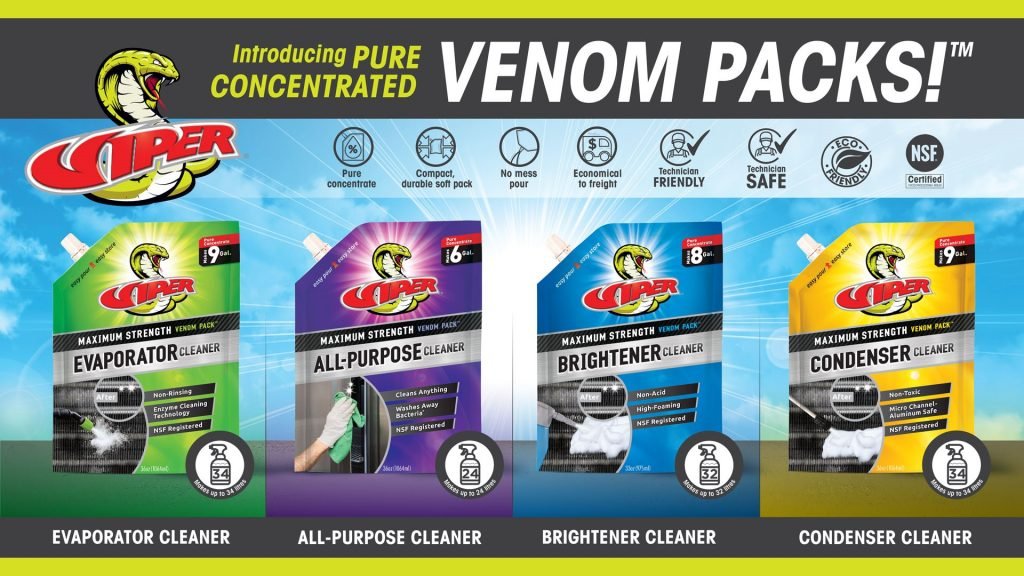
We love the Viper Venom Packs at Kalos! – They are highly concentrated in a nearly indestructible packaging with a small, convenient fill spot that you can use with an opening as small as a spray bottle with no funnel. They take up less space and are less like to spill if they fall off a shelf in the van. They come with all the standard cleaners as well as a neutral all purpose cleaner which comes in handy for lots of cabinet cleanup jobs.
Proper dilution for concentrated cleaners is key so we made this video to explain in detail
Some Final Thoughts
I know I didn’t cover the entire spectrum of cleaners here. I didn’t even touch on ice machine cleaners or go in-depth into the chemicals used to descale cooling towers. However, I think this article can serve as a starting guide for technicians beginning to learn the chemical cleaning tools available to them during the maintenance seasons.
When cleaning split coils, always take the time to remove the hail guards and the top of the unit so you can split the multiple layers of the coil apart and clean/spray between the coils. Also, it is best to rinse and spray from inside the unit outwards. That way, the leftover dirt is not pushed further into the coil.
Also, when using acidic or alkaline cleaners on rubber rooftops, pay close attention to your mixing ratios and be sure to always rinse the cleaner thoroughly off the rooftop. Many of the cleaners we use can deteriorate the roof membrane and cause water leaks down the road.
Everyone has their preferences in the cleaners they use, but even if you think you know what you like, I encourage you to be thoughtful and evaluate whether you really need to be using an “Extra Heavy Duty” coil cleaner on every maintenance.
As always, RTFM! Go the extra mile on your next coil cleaning, too. Clear out those leaves and twigs at the bottom of the outdoor unit, and wipe down the top of the condenser and compressor with a quick wax and shine!
—Kaleb Saleeby
Other Resources:
https://www.diversitech.com/en-US/
https://hvacrschool.com/podcasts/coil-cleaning-with-john-pastorello-podcast/
https://hvacrschool.com/videos/dirty-coil-clean-in-place-podcast/
https://hvacrschool.com/videos/how-to-clean-a-condenser-coil/
https://hvacrschool.com/videos/cleaning-an-hvac-slant-evaporator-coil-in-place-using-viper/
https://hvacrschool.com/videos/splitting-and-cleaning-condenser-coils/
https://hvacrschool.com/condenser-coil-cleaning-step-by-step/
https://hvacrschool.com/careful-with-cleaners/
https://hvacrschool.com/cleaning-condenser-coils-still-works/











Comments
What is your take on so called micro channel safe coil cleaners?
What is your take on so called micro channel safe coil cleaners?
Система IQOS представляет собой инновационный продукт для использования табачных стиков.
В отличие от обычных сигарет, здесь используется принцип нагрева.
Многие пользователи отмечают, что такой формат отличается иным восприятием.
Устройство отличается простым управлением, что делает его удобным в разных ситуациях.
Современный дизайн позволяет IQOS органично вписываться в повседневную жизнь.
Производитель уделяет внимание деталям конструкции, что повышает общий уровень удобства.
Регулярное обслуживание помогает продлевать срок службы устройства.
Таким образом, IQOS остаётся одним из вариантов альтернативных решений для тех, кто интересуется подобными технологиями.
https://terea777.shop/product/terea-sienna/
Система IQOS представляет собой инновационный продукт для использования табачных стиков.
В отличие от обычных сигарет, здесь используется принцип нагрева.
Многие пользователи отмечают, что такой формат отличается иным восприятием.
Устройство отличается простым управлением, что делает его удобным в разных ситуациях.
Современный дизайн позволяет IQOS органично вписываться в повседневную жизнь.
Производитель уделяет внимание деталям конструкции, что повышает общий уровень удобства.
Регулярное обслуживание помогает продлевать срок службы устройства.
Таким образом, IQOS остаётся одним из вариантов альтернативных решений для тех, кто интересуется подобными технологиями.
https://terea777.shop/product/terea-sienna/
To leave a comment, you need to log in.
Log In